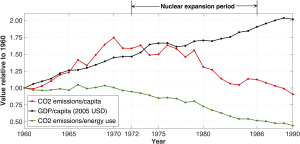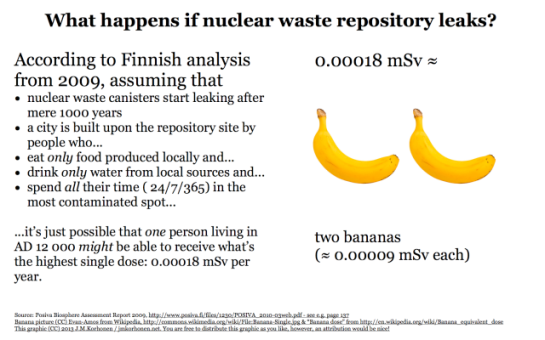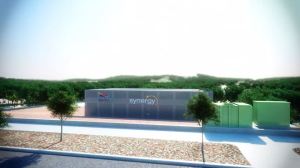But it’s the climate! Extreme weather events, rising sea levels, ocean acidification, Venus Syndrome… What could be more important than acting right now to mitigate these potential impacts?
The conversation around welcoming nuclear energy into the mix of measures to address this, and other challenges such as energy access in developing nations, has engaged a huge number of people in just the last year. But if you ask an anti-nuclear campaigner – despite all their online petitions to urgent climate action and umbrage towards deniers – then you’ll hear about different priorities.
1. Nuclear Waste
The waste left over from the generation of nuclear electricity is insidious and toxic. It can’t be stored safely enough, it will somehow be made into bombs and distant future generations will be poisoned when they unintentionally dig it up.
 After the tsunami rolled over the Fukushima Daiichi plant in 2011, campaigners made great mileage over the potential danger of the spent fuel pools. But as expected by actual experts, the material was unloaded and moved elsewhere without incident. Less was said about the long term stored fuel in dry casks, which got pretty wet but survived the worst earthquake and inundation in thousands of years.
After the tsunami rolled over the Fukushima Daiichi plant in 2011, campaigners made great mileage over the potential danger of the spent fuel pools. But as expected by actual experts, the material was unloaded and moved elsewhere without incident. Less was said about the long term stored fuel in dry casks, which got pretty wet but survived the worst earthquake and inundation in thousands of years.
Other sorts, like France’s separated final waste from decades of powering the whole country without emissions, is encased in cylinders and stored under one floor, of one room, in one building.
By-products from nuclear reactors were already buried underground billions of years ago, and their geochemical behaviour isn’t a mystery.
Actual risk assessment of deep geological disposal puts a big, fat question mark over all the time, effort and money spent by anti-nuclear campaigners:
The reasons that used fuel hasn’t and won’t ever be used to make weapons are technical but worth researching. Anti-nuclear campaigners certainly won’t write about the technical barriers to trying – let alone the fact that commercial nuclear power production has directly disposed of far more weapons than any other disarmament effort to date.
Similarly, storing it until we fission it, taking care of the “problem” completely, is surely the best way to tick everyones’ boxes?
2. Liberalised Market Interference
Western competitive energy markets aren’t interested in nuclear because it costs too much and takes too long. This is why citing France in the past or China today is easy to dismiss – they only have their reactors because of unsustainable government support. There are a few plants being built by monopoly supply companies, but they still need support like loan guarantees. And the huge cost could instead fund renewable energy.
Imagine, just for a second, that rapid and historically-guided climate action was widely prioritised above free market forces, and many Western and developing nations embarked on modern nuclear build programs no more rapid than the average achieved by Sweden last century (with 1960s designs). These scientists did, observing,

Fig 1. Swedish total CO2 emissions and GDP per capita 1960–1990, normalized to the level of 1960.
Replacing fossil-fuel electricity and heat production eliminates roughly half of the total source of anthropogenic CO₂ emissions. Continued nuclear build-out at this demonstrably modest rate (Sweden was not, at that time, motivated by urgent concerns like climate-change mitigation), coupled with an electrification of the transportation systems (electric cars, increased high-speed rail use etc.) could reduce global CO₂ emissions by ~70% well before 2050.
What happens in these sacrosanct liberalised energy markets when nuclear capacity is shuttered? The lesson of Vermont Yankee suggests it’s replaced with fossil fuels. Even in California, with its ambitious emissions targets and renewable portfolio standards, the same occurred with San Onofre Nuclear Generating Station. There are now legitimate fears that the lack of recognition of Diablo Canyon‘s climate-friendly contribution will also see it close and replaced with more gas capacity to fill the gap in firm demand.
If opportunity costs were the critical determinant some insist they are, then nobody told Southern Company in the US, who are rolling out new reactors alongside solar and wind plants. This is expensive, first-of-a-kind technology, but nuclear doesn’t need to be prohibitively expensive.
Then there’s the ambitions of Morocco: boasting a vast and expanding concentrating solar thermal facility while also laying the framework for nuclear build-out.
But back in Australia? Interim findings from the Nuclear Fuel Cycle Royal Commission confirmed that new nuclear energy capacity couldn’t compete in our market. On its own. With assistance – not even direct finance, just loan guarantees to reduce the discount rate – analysis suggests (page 89) building reactors becomes viable “if they were believed to have additional societal benefits, particularly around climate change, that may not be fully valued by the markets”. Even without a carbon price. Even without some sort of large scale generating certificate (though they would ostensibly seem to apply to such a low emissions energy source).
3. Popularity Contests
Not only is nuclear energy struggling to maintain a social license, alternatives like solar and wind are way more popular and have the support of every environmental organisation and numerous governmental energy transition schemes. Trying to build reactors now, either conventional or next-generation, in the face of so much opposition, would be a waste of precious time.
Everyone can point to the Chernobyl accident 30 years ago and say “bad idea”, and no one does this more than anti-nuclear campaigners, with outlandish predictions of up to 985,000 deaths after all is said and done.
Under similar conditions of national despotism and secrecy, the Banqiao Dam collapsed almost 41 years ago. Nobody – especially those same campaigners – cites the 171,000 actual fatalities, the devastation to towns and environment, and demands “No Hydro!”
Nuclear power is a scientifically and technically intensive proposition, without anything like the familiarity of charcoal grills, gas stoves or rooftop solar. Anti-nuclear campaigners have done their utmost for decades to fill that knowledge void and keep genuine curiosity and discussion OUT. But now the converts and the industry itself are raising their many voices, while it is increasingly being realised that clean alternatives have real limitations.
To other people, there are other things more important than climate action. The difference is that most of these folks haven’t adopted climate as their cause, then hogtied themselves from solving it.
@ShellenbergerMD @ha_nah_nah One of the gaps between many sceptics and environmentalists has long been incredulity at proposed solutions.
— Chris Baker (@Zacnaloen) April 22, 2016










 In this vein, let’s look at what’s worth all this money. Used fuel out of light water reactors looks just like fresh fuel, it’s just extremely radioactive. It’s so “hot” that over ten metres of water is used to ensure plenty of shielding, which results in intensely bright Cherenkov radiation. However, it is no longer being irradiated and is already losing its overall radioactivity.
In this vein, let’s look at what’s worth all this money. Used fuel out of light water reactors looks just like fresh fuel, it’s just extremely radioactive. It’s so “hot” that over ten metres of water is used to ensure plenty of shielding, which results in intensely bright Cherenkov radiation. However, it is no longer being irradiated and is already losing its overall radioactivity.

